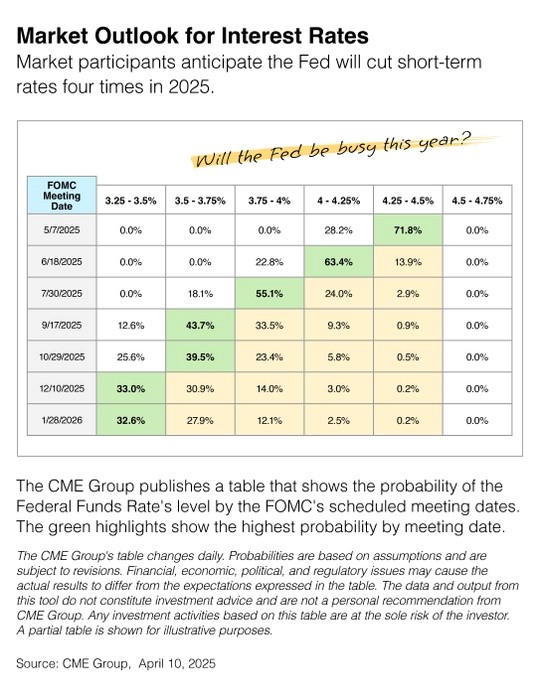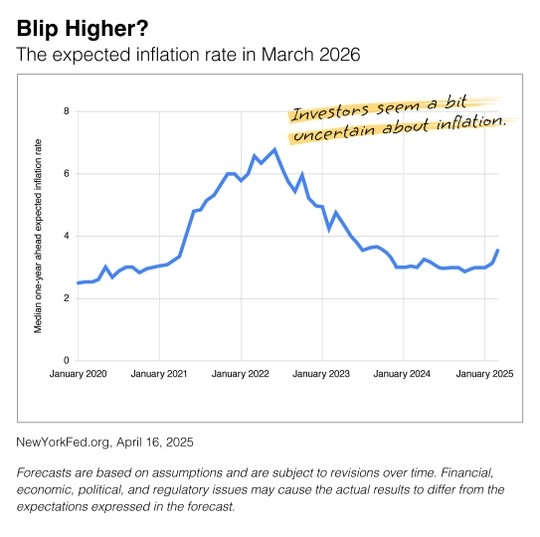Upbeat Inflation Report Lost in Tariff Shadow
Inflation’s Mixed Messages
The March consumer inflation report, which showed some prices at their lowest level in more than four years, was overlooked among all the tariff headlines.
Core inflation, which excludes the volatile food and energy factors, rose at a 2.8 percent annual rate, the best number since March 2021. A few months ago, Wall Street would have cheered the news. But with all eyes on tariffs, few were even talking about the report.
One thing is certain: the March news makes the Fed’s decision on short-term interest rates more interesting. On one hand, inflation is trending lower, and job growth is strong, so the Fed might consider adjusting rates to help economic growth. On the other hand, trade talks are a wild card, as some investors fear tariff-driven price increases could start to feed into the economy soon.
However, as today’s table shows, market participants expect the Fed to look past tariffs and adjust rates four times in 2025. Market participants believe concerns about a recession—a decline in economic activity that lasts more than a few months—may push the Fed to adjust as early as June. (The Fed funds rate is currently in a target range of 4.25 percent and 4.5 percent.)
 The economy always sends mixed messages, but recently, trade issues have compounded the situation. If you’re having difficulty wrapping your head around what’s happening, we are here and ready to help.
The economy always sends mixed messages, but recently, trade issues have compounded the situation. If you’re having difficulty wrapping your head around what’s happening, we are here and ready to help.
Sources: CNBC.com, April 10, 2025
Market Insights
U.S. stocks slipped over the shortened trading week as Q1 corporate reports started to roll in.
The Standard & Poor’s 500 Index dropped 1.50 percent, while the Nasdaq Composite Index fell 2.62 percent. The Dow Jones Industrial Average lost 2.66 percent. The MSCI EAFE Index, which tracks developed overseas stock markets, added 4.19 percent.
U.S. Stocks Slide
Stocks started the four-day week with modest gains. Trade volatility subsided as several money center banks reported Q1 numbers at or above expectations. Stocks trended lower midweek after Federal Reserve Chair Jerome Powell expressed concern that tariffs would likely “move us further away from our goals”—including keeping inflation in check.
Stocks were mixed on the week’s last trading day as traders evaluated White House news that trade deals were progressing with Japan, China and the European Union. The S&P 500 ended the day higher, but the Dow Industrials were under pressure after a large healthcare company gave a disappointing Q1 report.

Source: YCharts.com, April 19, 2025. Weekly performance is measured from Monday, April 11 to Thursday, April 17.
TR = total return for the index, which includes any dividends as well as any other cash distributions during the period. Treasury note yield is expressed in basis points.
Who’s Right on Inflation? Fed, Shoppers or Investors
Tracking inflation is like herding cats these days.
Should you believe the monthly updates from the Bureau of Labor Statistics, what the Fed says about future prices or your own experience at the grocery store?
The answer is maybe a little of all three.
The March Consumer Price Index (CPI) report, which looks at the past 12 months, showed core inflation rose at a 2.8 percent annual rate, the best number in four years—an encouraging update for investors. However, a few days earlier, the New York Fed said its March inflation survey, which looks ahead 12 months, showed prices trending higher in 2025 and reaching 3.6 percent in a year.

What about today’s prices? Take eggs, for example. Wholesale egg prices have fallen, but you might not see much relief at the checkout line as a shopper. Confused? You’re not alone.
The expression “herding cats” means a task that is exceptionally difficult or frustrating. That certainly can describe getting a handle on inflation these days! At times like this, we encourage people to “tune out the noise” and remain disciplined with their overall investment strategy.
Source: TradingEconomics.com, April 16, 2025
